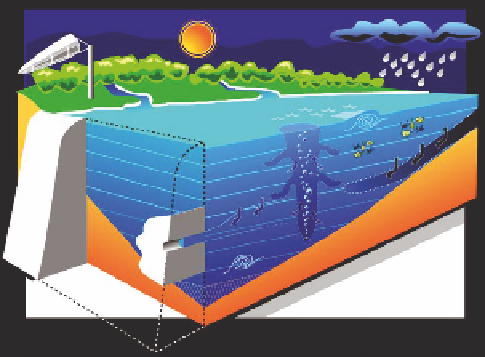Environmental Engineering Reference
In-Depth Information
13.3 WHAT ABOUT DAMS?
The transport processes in lakes and reservoirs are controlled by natural variations in inlows,
outlows, and meteorological forcings. In man-made reservoirs, the transport and mixing are also
controlled to a large degree by the manner in which they are regulated by the dam(s) that formed
them (Figure 13.11).
13.3.1 p
roject
p
urpoSeS
and
r
eSerVoIr
o
peratIonS
The project design and operation of reservoirs directly impacts the physical transport within the res-
ervoir and the magnitude and quality of the release waters. Therefore, regulation of the water levels
within reservoirs affects their quality and productivity. For example, in some lood control reser-
voirs, seasonal drawdown of the water level provides additional lood storage capacity. However,
the drawdown may reduce breeding areas along the shoreline, affecting isheries and productivity.
The impact of reservoir operations on transport may be illustrated by hydropower reservoirs.
Reservoir operations to produce electricity using water releases, or hydropower, affect both mixing
and quality characteristics. Hydropower reservoirs are generally of two types: base load and peak-
ing hydropower operations. Base load operations occur over relatively long periods of time during
the day. As an example, an increasing number of low-head hydropower facilities produce electricity
by continuously releasing water from relatively shallow reservoirs. In contrast, peaking operations
release water and generate electricity only during peak demand periods. A typical hydropower dam
is illustrated in Figure 13.12. Water may be released for only a few hours during the day and opera-
tions may show signiicant weekly and seasonal variations. These peak demands are typically in
the morning and the evening during the week. Heating demands during winter, and cooling during
summer, result in seasonal variations. The rapid releases that occur during hydropower operations
produce rapid variations in reservoir and downstream water levels, thereby affecting mixing in both
reservoirs and streams.
Pump storage hydropower operations produce special mixing and water quality characteristics
and differ from conventional operations. In one coniguration for pump storage peaking hydropower
reservoirs, water is released from an upper reservoir to create energy during peak demand periods
and then captured and stored in a lower reservoir. That is, the release water is stored in a typically
lower reservoir (the storage reservoir) and then pumped back to the upper reservoir during periods
of low demand when power may be obtained at reduced costs. Another coniguration is illustrated
FIGURE 13.11
Reservoir transport and mixing patterns. Simulated in DYRESM model. (Courtesy of Jorg
Imberger, Center for Water Research, University of Western Australia.)

Search WWH ::

Custom Search